Keywords: Christchurch - public art - community - Gap Filler
For more than three years now, Christchurch has been a city completely in transition, almost without a present tense. It is a post city, the remains of the complicated, contradictory, post-colonial place it once was, with a centre that is 70 per cent destroyed and sparsely populated. It is also, now, a pre city, with three years’ worth of plans, consultation, ideas and designs that exist mainly as a massive set of aspirations yet to be enacted. In between the past and future, the present tense consists mostly in still cleaning up and continuing to demolish the old; and making grand plans, lodging consent forms, battling insurance companies, and waiting for government and private developers to rebuild our city.
One of the relatively few and relatively prominent things actually happening in the present tense has been Gap Filler, an initiative started in October 2010 that has been running creative projects on vacant sites in Christchurch. We’ve been conceiving events and installations, building community and experimenting amidst the ruins of the nineteenth and twentieth century city. We temporarily reshape the urban environment in a quick and rough way, without waiting for the government’s or developers’ plans and permissions.
It was predictable that people here would take what they could into their own hands. When the normal ways of doing things are inadequate, those in power have to start revising the rulebook and reasserting control. Others inevitably start doing what they feel is necessary and lacking, and hope that the rulebooks will catch up.
This DIY approach has gained many fans, supporters and accolades along the way and given rise to an experimental creative movement in Christchurch among which we’d include Greening the Rubble, Life in Vacant Spaces, FESTA (The Festival of Transitional Architecture), The Social, Plant Gang and more. This vibrant movement is striving to reinvent the city, but it’s unclear whether and how these temporary activities might have a lasting impact – which is what I want to question in this essay.
A propositional mode of development
I don’t blame private developers for taking their time and being cautious, when eight- and nine-digit sums are at stake in a place rife with uncertainty. And I don’t wish to reproach governments (too much) for being slow, especially if that slowness had been due to fulfilling their moral and statutory requirements to involve the community in large-scale publicly funded projects.
Broadly speaking, these two conventional modes of development generate the entire built form of a city. Nearly every structure is a private development undertaken by an individual, organisation or company as an investment, or a public creation (building, park, square, artwork, road, footpath) funded and commissioned by the government on behalf of its constituents.
Private developments are made without public consultation, or rather with an arcane form of consultation that involves trying to predict market forces and future consumer demand. Public developments are obliged (as they should be) to be consultative, though the nature of much consultation methodology entails that outcomes are almost always conservative and comfortable; there’s not much room for pushing boundaries.
Another possibility, which Christchurch has been exploring, is what we’ve come to call a propositional mode of development. After the September 2010 quake, we hypothesised (quite safely) that people were suffering from a dearth of places to gather and socialise in the central city. We borrowed a patch of dirt where two buildings had been demolished and spent several hundred bucks to turn it into a kitschy public park for two weeks, with fake turf, garden furniture from the dump and beach umbrellas. We invited people to hang out and bring a picnic, and we had an open mic if anyone wanted to take it.
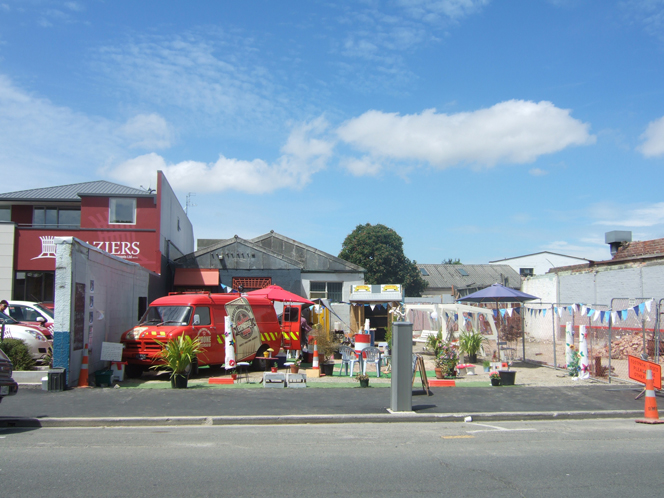
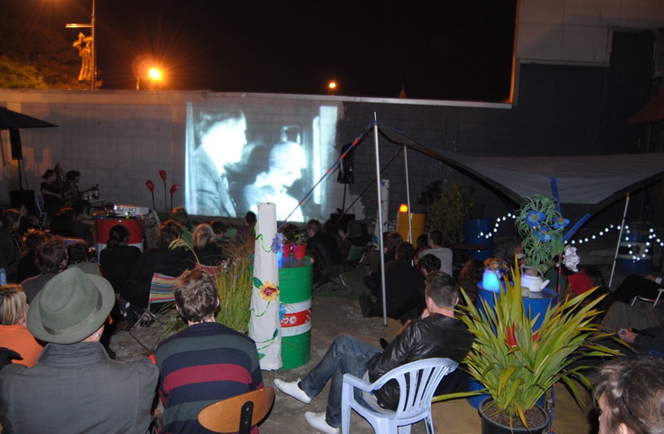
Our hypothesis seemed true: people came in greater numbers than we expected, and the camaraderie was palpable. The ‘stage’ was in constant use; over two weeks, more than 30 bands played, and there were poetry readings, circus performances, puppetry shows and more. People told us that, if they weren’t a planner, developer or architect, they felt left out of the rebuild. Taking the stage was a way for them to feel involved.
The turnaround time and organisational lead-in were incredibly short, and we were self-funding it, so the site itself was a bricolage of readily available materials. The performances, too, were readily available, pre-existent. No performances, music or films were created especially for this project (apart from a poem or two). Rather, the content already existed and was thrown together in this new context. Human interactions were the glue that held the disparate elements together.
The public response to this small accomplishment totally exceeded our expectations. Many people confided in us their own ideas for what could or should be: the gap became a space that allowed people to project their own desires, at least some of which spoke to the much bigger picture of what Christchurch could be – less stuffy and conservative, more inclusive and collaborative, open to trying new things. People responded less to what we actually created, our kitschy garden and performance space, and more to the concept of the gap itself as a space of possibility. We’ve now created around 45 projects and facilitated 40 more, and have learned a great deal from our experiments – and we still carry with us this original discovery that people care less about us and what we create than about the implicit invitation to engage their own imaginations.
This propositional mode, we now believe, is well suited to generating public support for innovation. We try to perceive and identify deficiencies in the city and offer active solutions, involving enthusiasts and professionals at any stage. We create a project – an artwork, a public space, an amenity – and place it in the public realm as a temporary, small-scale, low-cost and low-risk experiment. More consultation, so to speak, comes from monitoring how the public uses, embraces, ignores or rejects the project. We have to watch, listen and reflect, then adapt it (or remove it) in response to implicit or explicit feedback. If a project ‘fails’, not much time and money is ‘lost’, and it provides useful learning for future projects. If a project ‘succeeds’, it can last longer, or have iterative additions. We operate, in this respect, like an agile small business – but our bottom line is the benefit to the public. It’s a form of social entrepreneurship.
Our best bang for buck has to be the Think Differently Book Exchange, a broken old commercial refrigerator that was salvaged, placed on a vacant site and filled with books at a time when the city libraries were all closed. (The basic idea was suggested to us by a temporarily out-of-work librarian.) We placed a bench nearby, and a pathway of paving stones leading from the footpath, and left it there for anyone to use any time of day or night. All up it cost us maybe a hundred dollars.
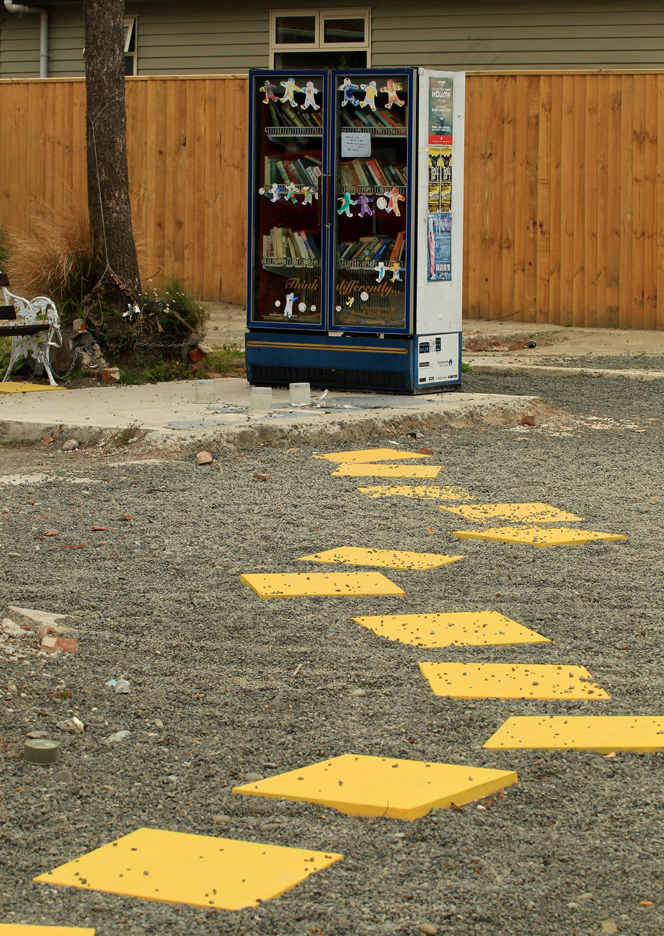
Anything could have happened: everyone might have ignored it, or someone might have ‘stolen’ all the books, knocked it over or vandalised it. But people used it, and kept donating books. And the neighbours started caring for it, putting calls out over social media for more donations when it was getting empty. What was originally intended to be there a few months lasted much longer. It has subsequently been knocked over and the glass shattered, but somebody picked it up, sealed it and cleaned up the glass before we even knew about it. Now three years have passed and it’s still being used regularly – and there have been a few ‘copycat’ exchanges created in the suburbs by others.
Fluidity of roles
We have developed into a values-based and outcome-focused organisation. We strive for social impact – engaging the community, empowering people to be involved in the tangible reimagining of the city, collectively experimenting and sharing the results of those experiments. The result is that we tend to evaluate the ‘success’ of our projects differently to how government or a private developer would.
A few months on from the February quake a land owner in Lyttleton, a little port town just over the hill from Christchurch, rang and offered us temporary use of her vacant site. Lyttelton had never had a town square, and with all of the bars and cafes closed there was a palpable lack of gathering spaces. We met a bunch of locals, spread the word and hosted a few working bees to transform the barren site into a social space. A bit of residual foundation was designated as the ‘stage’ and people set about building tables and chairs out of recycled timber and pallets, and levelling some of the ground to create a petanque pitch.
The Lyttelton Petanque Club, as it was named, was far from polished and pretty. But people used it, and seemed to feel pride in it. Every time I ventured back to the site, there were additions: someone made more furniture; someone planted herbs; someone dug out a sandpit and left toys there; and so on. This was perhaps unexpected, but we view it now as a sign of success. People felt empowered to contribute, even without our permission or involvement, and to continue to transform the space, which was perhaps more public in practice than any ‘public’ park we know of. By traditional ‘park’ criteria, the site was unkempt, unplanned and unfinished, but these very characteristics seem to have helped it be empowering, participatory and unrestricted.
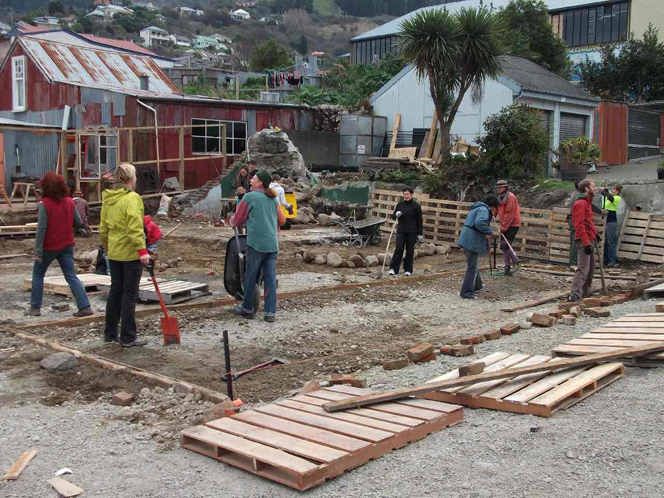
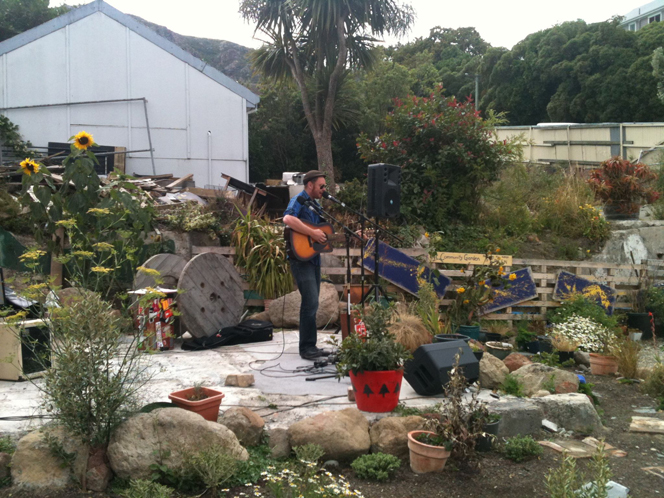
With these atypical notions of ‘quality’ and ‘success’, we have developed into quite a fluid organisation. Sometimes we are the artists or creative initiators who conceive and create a project; other ideas are suggested to us and we develop and implement the idea with the originator; sometimes we develop briefs, or run competitions, and act as the producer or funder of a project. When there’s a good idea that aligns with our objectives, we play whatever role or roles we must to help see it through to fruition and secure the social outcomes. This does cause confusion at times because people (and funders and sponsors) are more accustomed to defined roles: architects design buildings but don’t construct them; builders follow plans but don’t make them. We blur such restrictions and disciplinary boundaries – challenging some of the social conventions that operate, in practice, like rules.
Both conservative and progressive
All of our projects are in some ways based on conservative principles – restoring lost amenities; indulging some nostalgia and sentimentality; creating a ‘village gathering’ atmosphere, with a strong emphasis on physical presence and interactions outside of commodity culture; and often embracing ‘amateur’ content. But every project also has a progressive element, or perhaps those traditional distinctions no longer hold.
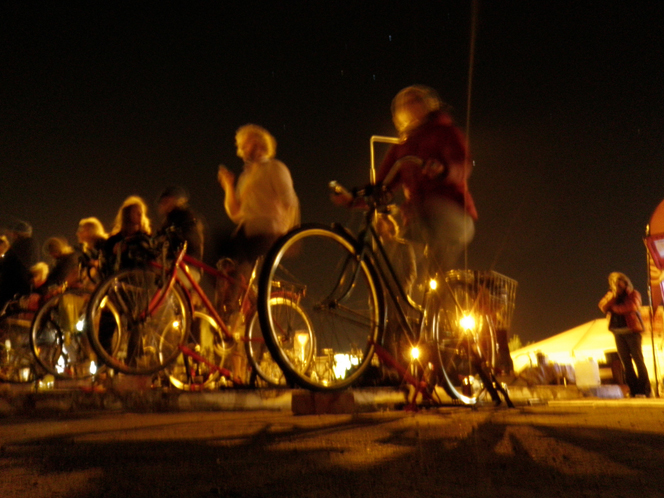
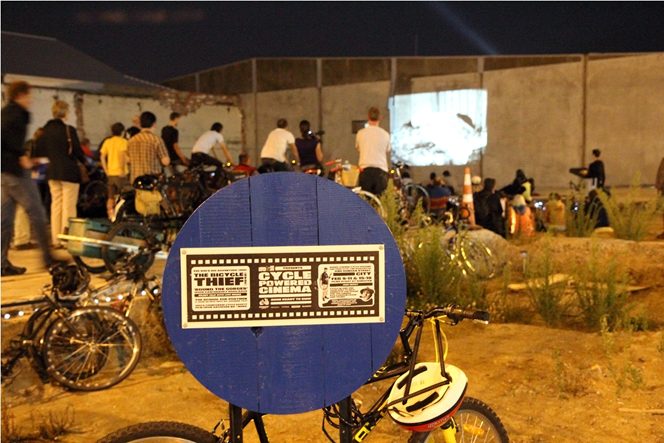
For our fourteenth project we created the Cycle-Powered Cinema, which ran for two weeks on a city site where Christchurch’s oldest cycle shop used to be. It took ten riders at a time – who connected their own bikes into the system – to power the sound and projector to screen the cycle-themed films. It was a bittersweet occasion: remembering and farewelling the old Cycle Trading Company; providing an outdoor cinema when all the central city cinemas had been destroyed; and enjoying many films that celebrated (or mourned the passing of) a ‘simpler’ time when cycles outnumbered cars and life was less hectic. But the form or frame for this nostalgic content – and the inherent symbolism of activating dead private space and making it public – gives it a different colour. Cycle power is both pre-modern (simple and mechanical) and absolutely contemporary in terms of sustainability and cutting-edge urbanism. We gave a tangible expression to the much-voiced possibility of Christchurch becoming a model for sustainable twenty-first century cities.
The book fridge is arguably similar. It’s a token (conservative) gesture at restoring some of the city’s lost services. But the layout of the site may invite new thoughts and experience. We deliberately put no sign on the footpath explaining it, and one can’t tell what’s inside from that far away. A big fridge on a vacant site doesn’t make immediate sense, but it is obviously intentional, with a pathway leading there. It invites people to overcome social barriers, become curious and venture onto the site. The book exchange arguably becomes more than a simple book service or amenity (though it is that too): it can provide a brief experience outside of our conventional social logic.
Whether these projects ultimately support or challenge the status quo may hinge on the question of whether they are seen to ‘just’ fill a need until a more permanent solution can be found, or have ongoing influence inspiring new ways of thinking about the creation – and ‘ownership’ – of city space. At the end of a project the landowner still owns the site and will doubtless build something unaffected by our activities. If we have long-term impact, it’s unlikely to be material; it will be in the immaterial realms of memories and desires.
The transitional
Gap Filler originated shortly after the September 2010 quake, when there were perhaps a couple dozen demolished buildings. We conceived of Gap Filler in both a spatial and temporal sense as trying to fill those few bare sites with activity, with no thoughts on changing the city in the longer term.
But we discovered an unexpected value in our first couple of projects and, with the far more damaging quake of February 2011, we began to view these small-scale and short-term projects as great ways to encourage experimentation and express a different mode of city-building that can evolve and possibly feed into long-term plans.
I now sometimes feel we are saddled with a name – Gap Filler – that has conservative and pejorative connotations. It implies that we’re just biding time and distracting people until the ‘real’ rebuilding can happen, rather than (as we wish) engaging people, involving them in the city’s renewal and transforming how they desire their urban environment to be shaped.
After two years as a Gap Filler project, the Lyttelton Petanque Club site has been bought by the city to be developed into the town square Lyttelton never had. We hope that, after experiencing a space where they felt able to contribute and make additions, people will demand a different sort of space from, and relationship with, the city – that residents and local government both learn something from our experiment, as we did.
We and our sibling organisations stopped referring to our various projects, and ethos, as ‘temporary’ and began to use the now-preferred term ‘transitional’. Through using this term, we (imperfectly) try to encapsulate this aspiration to influence what comes next. Perhaps a term like ‘trailblazing’ would be clearer; we try to forge some alternative paths and ease the way for others to take them too.
Gap Filler built and operated the Pallet Pavilion, a large community event space constructed out of 3000 pallets. The Pavilion had some costly design flaws, and taught us about navigating tricky parts of Council’s consent process. Both of these things we record and make public, so that we and others can do similar projects better and faster the next time. During its 16-month lifespan, it attracted other projects to the vicinity with a similar vibe and communal outlook: collectively built micro-architecture, social enterprises and small businesses (especially food trucks). The Pavilion has been deconstructed (as planned), but the site retains the flavour the Pavilion established and is developing into The Commons, a values-based cooperative development . One use influences the subsequent.
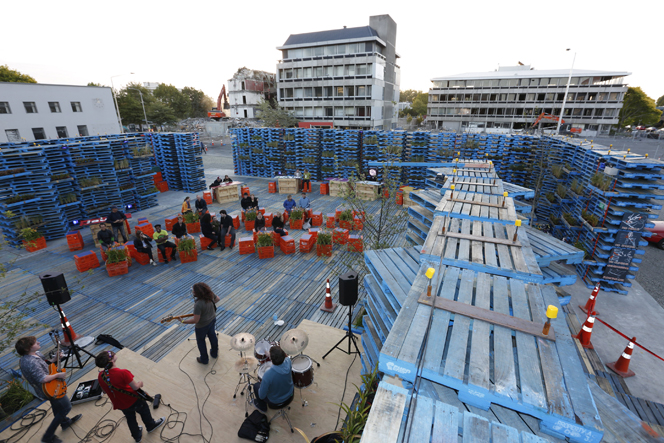
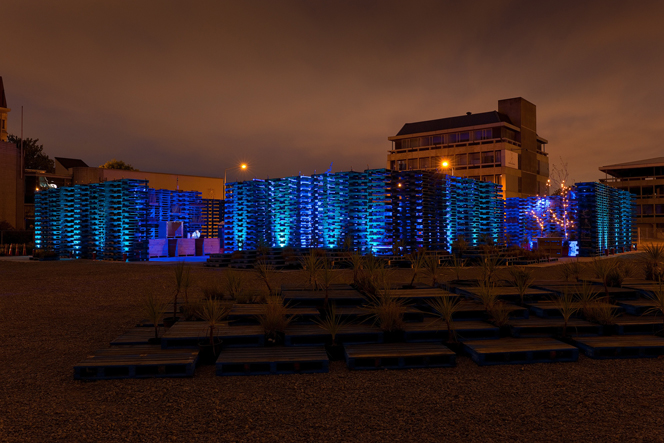
The site of The Commons is adjacent to one of the Government’s major rebuild anchor projects, the Avon River Park. We’ve had a few discussions with the contractors designing that project, but it remains to be seen whether our experiments on this site will in any way influence their so-called ‘permanent’ plans. Certainly they don’t seem to be employing anything of the inclusive process we use to conceive, develop, build and activate our projects, instead preferring to develop their designs behind closed doors and without public input or involvement. The development process, then, might become the political battleground of our ‘transitional city’ movement.
The metropolis and mental life
In some ways, Christchurch has been cast back to the turn of the twentieth century when it was an emergent city, and is experiencing the same disputes over what a city is and how it should develop. ‘The Metropolis and Mental Life’ is a well-known 1903 essay by Georg Simmel. Reflecting from the midst of the first period of rapid urbanisation, he regards cities as creations where the dialectic of individual and society is for the first time revealed as a root condition of human life. Cities force us to debate and determine how individuals can and should form societies – or how societies can allow room for individual choices, behaviour and absurdities.
Simmel writes of the metropolis: ‘Here in buildings and in educational institutions . . . is to be found such a tremendous richness of crystallizing, depersonalized cultural accomplishments that the personality can, so to speak, scarcely maintain itself in the face of it’ (Simmel: 338). An opposition to this depersonalised mode would have to develop techniques to liberate space and engender fluidity.
With the massive and controlling city plan that’s underway, Christchurch is in some key respects an even more rule-bound society than previously, despite the chaos and disorder. This inflexibility makes something like the ‘transitional city’ movement both crucial and probable – the carving out of spaces and times where the little people are asserting creative impulses and self-determination.
It’s interesting to consider that so far these gaps, these possible spaces for self-determination, have been populated primarily by a bricolage of arguably regressive or at least pre-existent contents but that it is the frame or form – the symbolic making public of private space, the absurd twists that make these assemblages more than mere amenities – that opens a progressive potential and invites unconventional thoughts and behaviours.
I found that Simmel offers perspective on this form-content relationship as well. In a 1910 essay on sociability and conversation, he writes: ‘In the serious affairs of life men talk for the sake of the content which they wish to impart or about which they want to come to an understanding – [whereas] in sociability talking is an end in itself; in purely sociable conversation the content is merely the indispensable carrier of the stimulation . . .’(Simmel: 136). In sociable conversation, the most widely inclusive sort, the contents are largely pre-established and known. We might say the same of many of the Gap Filler projects, not that the content is a matter of indifference – it must be interesting and significant – only it is not the purpose of the projects that the contents yield objective results. Our citywide mini-golf course is not ‘about’ golf or trying to ‘say’ anything about golf. That content is just the vessel for provoking people to explore their city and see the potential for experimentation and participation where they mightn’t otherwise.
Desire for the gap
Here I return to our initial discovery that people respond not only to the specific content of Gap Filler projects, but also, or more so, to the ideas behind or even the image of Gap Filler.
The content, sometimes superficial, is often eclipsed by a desire for the gap. I mean this in a spatial, temporal and political sense. A gap is a void where many things are possible. But it is not a complete absence of form: there are physical characteristics, like neighbouring walls, buildings or features. There is a heightened sense of history on each individual site and, standing on a bare site in full view of mass destruction and ongoing demolitions, one is squarely within a specific recent history.
I propose that many people have a desire for the gap in this spatial sense. Unlike most built form, which forcefully determines the sort of activities and interactions that can take place within it, a gap is largely indeterminate. It’s a space for self-determination that people find appealing, with just enough form to incite ideas. (People find the enormous featureless sites of the East Frame, for instance, daunting and unappealing, with nothing to ‘bounce off’.)
This desire for the gap also takes a temporal form. Anyone can run a project without sacrificing their existing commitments if there’s no need for it to endure. The temporary nature can encourage the trying out of ideas: there’s less pressure to get everything ‘right’ and design out uncertainties as with a major ‘permanent’ development.
This desire for the gap also exists in the political sense as a craving for meaningful difference when it feels like all political parties are just offering us different seats to the same show. We desire an inkling of possibility for fundamentally reshaping social interactions, for spaces conducive to sociability without pressure to shop, for inclusivity and for the possibility to be truly surprised.
In the immediate aftermath of the big quakes, there was – among the shock – a widespread sense that anything was possible. These gaps, at their best, can be preservations of that brief liberating potential: little bubbles in space-time that sustain the desire and belief – and therefore possibility – that meaningful change is achievable.
Fluidity of rules
Singing the praises of gaps, I risk sounding anti-development. How can we rebuild major developments whilst accounting for these ‘transitional city’ discoveries? The last essay Simmel ever published I find highly relevant: ‘Life must either produce forms or proceed through forms. But forms . . . contradict the essence of life itself, with its weaving dynamics, its temporal fates, the unceasing differentiation of its parts’(Simmel: 25). So he posits a ceaseless cycle where life creates cultural forms (buildings, institutions, organisations, anything) and then immediately finds the forms too constraining and starts rebelling against them. He writes: ‘Life perceives “the form as such” as something forced upon it. It would like to puncture not only this or that form but form as such’(Simmel: 12). We have collectively established these gaps as having a high degree of freedom from form in terms of space, time and ideology – yet with enough hint of those forms to trigger creative responses.
This observation suggests that rewriting the rules of our society is insufficient. The closest we could come to reconciling the individual and society would be by creating a society that more or less constantly rewrites its rules – its laws and regulations as well as its social norms and habits.
One of our most popular projects has been the Dance-O-Mat. It’s essentially an open space and a jukebox. We salvaged a coin-operated washing machine from a Laundromat and rigged it so that you plug in your music player or phone, drop a coin in and the speakers and lights come on for half an hour. It clearly fills multiple needs as a home for dance groups to rehearse and a venue for social events. But it also invites new social relations and interactions (where else would you find professional flamenco dancers mixing with hip-hop boys?) and is a springboard for other creative responses.
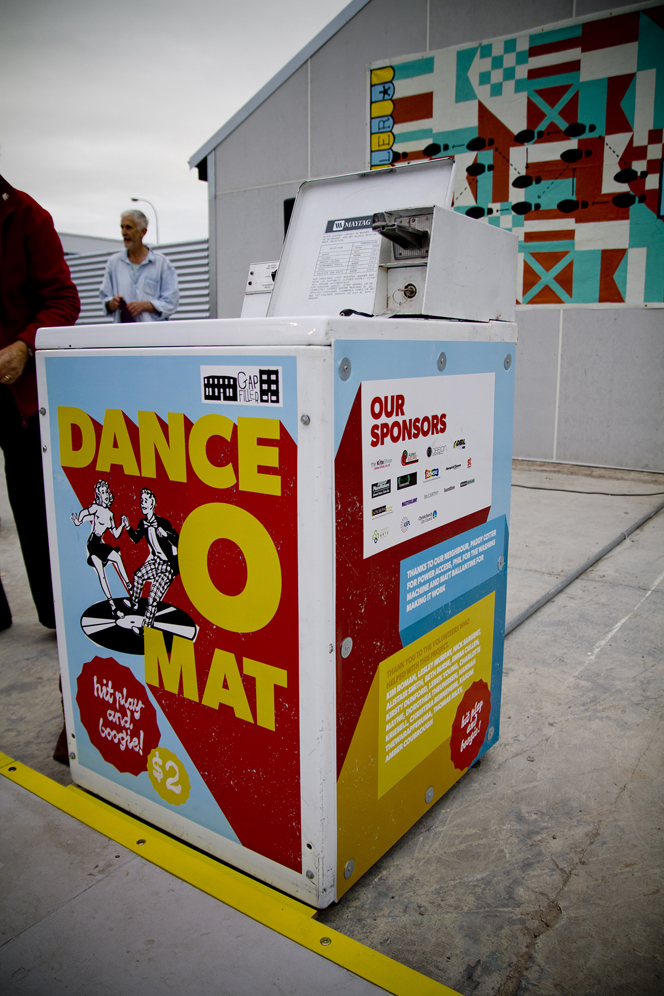
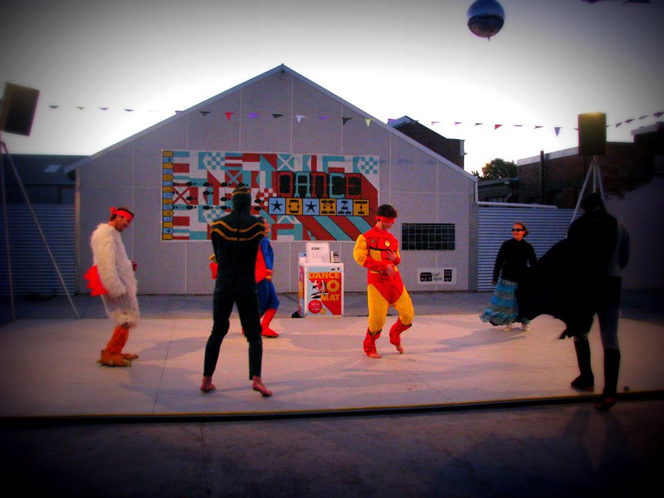
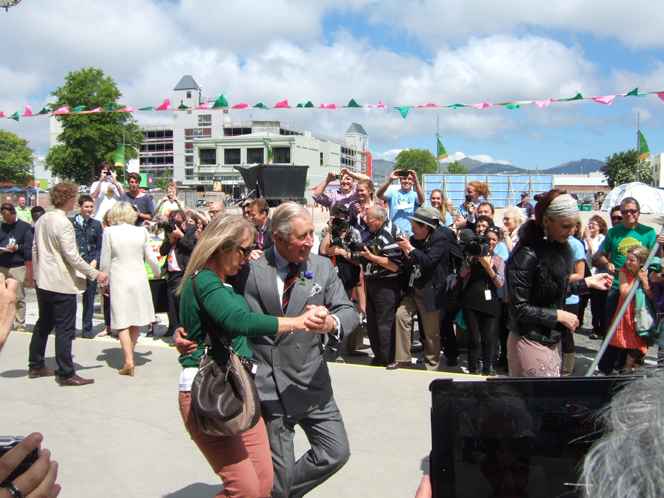
Dance-O-Mat is nothing more than a framed empty space, a space that suggests or invites ‘music and dance here’. Dance-O-Mat doesn’t contravene any rules, but it shatters certain conventions. When we first proposed the project, many people warned us that nobody in conservative Christchurch would dance in public – it was too far outside the social norms here. But people do! We made it okay for people to dance in public, not literally (through signs and text) but symbolically (through the arrangement of space).
When we removed the Dance-O-Mat from one site, we spotted a few people the following day dancing in the dirt of the site with a portable boom box. We’d transformed people’s conception of that space even beyond the physical presence of the project. But why wouldn’t they dance like that all over the city, and why hadn’t they been doing it all along? Even as we helped to relax the conventions of one space, we may have been implicitly reinforcing the conservative conventions of the rest of the city’s spaces. In addressing one need or issue, one inevitably creates others.
We try very hard to be fluid, responding to the changing context of the city and refusing to repeat ourselves. But we’ve also become part of the systems of the city, with ongoing support from Council, citizens, businesses and property owners. The test for us is to remain fresh and relevant. If we stagnate – or are perceived to stagnate – we need to step aside.
How else might one continuously challenge conventions to create a permanently transitional city, always creating itself anew?
This article originally appeared in Once in a lifetime: City-building after disaster in Christchurch 2014 Christchurch: Freerange Press and has been reproduced with permission of the author and publisher.
Simmel Georg 1972 ‘The Metropolis and Mental Life (1903)’, in On Individuality and Social Forms, Chicago: University of Chicago Press
Simmel, Georg 1972 ‘Sociability (1910)’, in On Individuality and Social Forms, Chicago: University of Chicago Press
Simmel, Georg 1968 The Conflict in Modern Culture, and Other Essays, New York: Teachers College Press